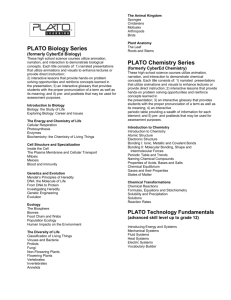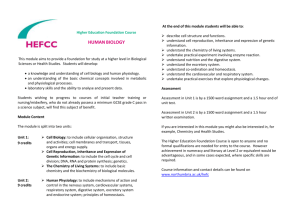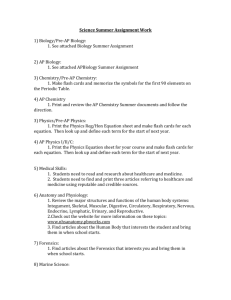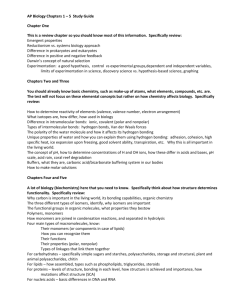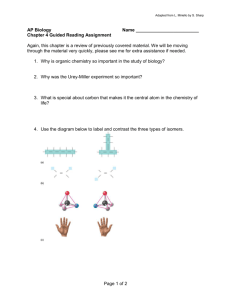File
advertisement
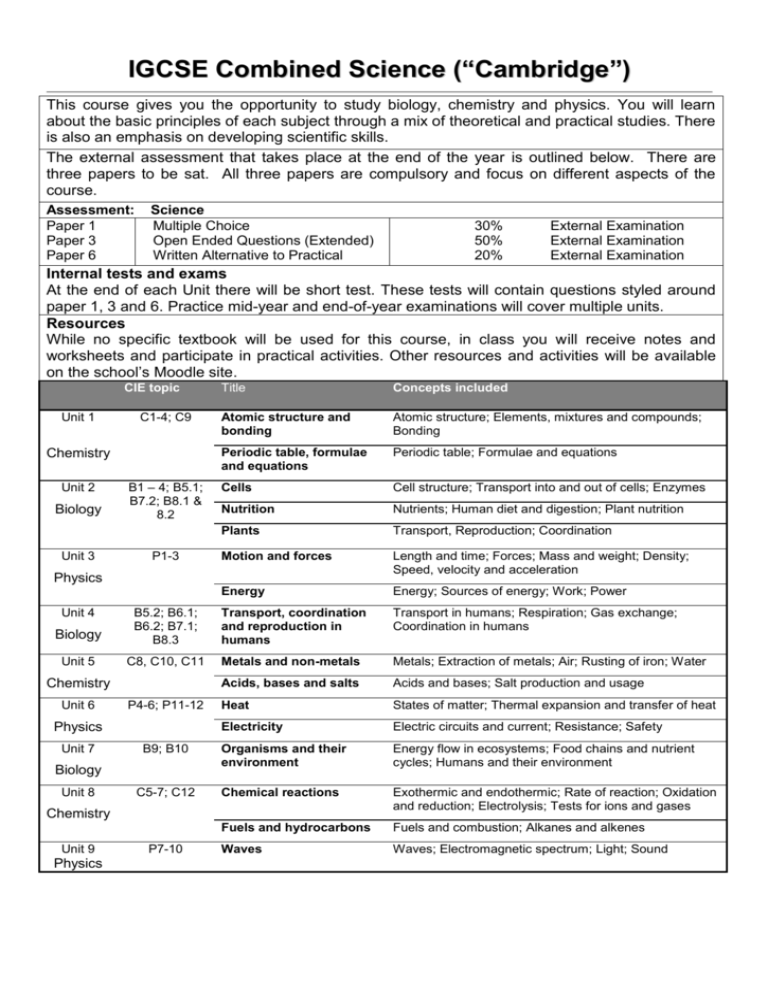
IGCSE Combined Science (“Cambridge”) This course gives you the opportunity to study biology, chemistry and physics. You will learn about the basic principles of each subject through a mix of theoretical and practical studies. There is also an emphasis on developing scientific skills. The external assessment that takes place at the end of the year is outlined below. There are three papers to be sat. All three papers are compulsory and focus on different aspects of the course. Assessment: Paper 1 Paper 3 Paper 6 Science Multiple Choice Open Ended Questions (Extended) Written Alternative to Practical 30% 50% 20% External Examination External Examination External Examination Internal tests and exams At the end of each Unit there will be short test. These tests will contain questions styled around paper 1, 3 and 6. Practice mid-year and end-of-year examinations will cover multiple units. Resources While no specific textbook will be used for this course, in class you will receive notes and worksheets and participate in practical activities. Other resources and activities will be available on the school’s Moodle site. CIE topic Title Concepts included Atomic structure and bonding Atomic structure; Elements, mixtures and compounds; Bonding Periodic table, formulae and equations Periodic table; Formulae and equations Cells Cell structure; Transport into and out of cells; Enzymes Nutrition Nutrients; Human diet and digestion; Plant nutrition Plants Transport, Reproduction; Coordination Motion and forces Length and time; Forces; Mass and weight; Density; Speed, velocity and acceleration Energy Energy; Sources of energy; Work; Power Biology B5.2; B6.1; B6.2; B7.1; B8.3 Transport, coordination and reproduction in humans Transport in humans; Respiration; Gas exchange; Coordination in humans Unit 5 C8, C10, C11 Metals and non-metals Metals; Extraction of metals; Air; Rusting of iron; Water Acids, bases and salts Acids and bases; Salt production and usage Heat States of matter; Thermal expansion and transfer of heat Electricity Electric circuits and current; Resistance; Safety B9; B10 Organisms and their environment Energy flow in ecosystems; Food chains and nutrient cycles; Humans and their environment C5-7; C12 Chemical reactions Exothermic and endothermic; Rate of reaction; Oxidation and reduction; Electrolysis; Tests for ions and gases Fuels and hydrocarbons Fuels and combustion; Alkanes and alkenes Waves Waves; Electromagnetic spectrum; Light; Sound Unit 1 C1-4; C9 Chemistry Unit 2 Biology Unit 3 B1 – 4; B5.1; B7.2; B8.1 & 8.2 P1-3 Physics Unit 4 Chemistry Unit 6 P4-6; P11-12 Physics Unit 7 Biology Unit 8 Chemistry Unit 9 Physics P7-10 IGCSE Combined Science (“Cambridge”) This course gives you the opportunity to study biology, chemistry and physics. You will learn about the basic principles of each subject through a mix of theoretical and practical studies. There is also an emphasis on developing scientific skills. The external assessment that takes place at the end of the year is outlined below. There are three papers to be sat. All three papers are compulsory and focus on different aspects of the course. Assessment: Paper 1 Paper 3 Paper 6 Science Multiple Choice Open Ended Questions (Extended) Written Alternative to Practical 30% 50% 20% External Examination External Examination External Examination Internal tests and exams At the end of each Unit there will be short test. These tests will contain questions styled around paper 1, 3 and 6. Practice mid-year and end-of-year examinations will cover multiple units. Resources While no specific textbook will be used for this course, in class you will receive notes and worksheets and participate in practical activities. Other resources and activities will be available on the school’s Moodle site. CIE topic Title Concepts included Atomic structure and bonding Atomic structure; Elements, mixtures and compounds; Bonding Periodic table, formulae and equations Periodic table; Formulae and equations Cells Cell structure; Transport into and out of cells; Enzymes Nutrition Nutrients; Human diet and digestion; Plant nutrition Plants Transport, Reproduction; Coordination Motion and forces Length and time; Forces; Mass and weight; Density; Speed, velocity and acceleration Energy Energy; Sources of energy; Work; Power Biology B5.2; B6.1; B6.2; B7.1; B8.3 Transport, coordination and reproduction in humans Transport in humans; Respiration; Gas exchange; Coordination in humans Unit 5 C8, C10, C11 Metals and non-metals Metals; Extraction of metals; Air; Rusting of iron; Water Acids, bases and salts Acids and bases; Salt production and usage Heat States of matter; Thermal expansion and transfer of heat Electricity Electric circuits and current; Resistance; Safety B9; B10 Organisms and their environment Energy flow in ecosystems; Food chains and nutrient cycles; Humans and their environment C5-7; C12 Chemical reactions Exothermic and endothermic; Rate of reaction; Oxidation and reduction; Electrolysis; Tests for ions and gases Fuels and hydrocarbons Fuels and combustion; Alkanes and alkenes Waves Waves; Electromagnetic spectrum; Light; Sound Unit 1 C1-4; C9 Chemistry Unit 2 Biology Unit 3 B1 – 4; B5.1; B7.2; B8.1 & 8.2 P1-3 Physics Unit 4 Chemistry Unit 6 P4-6; P11-12 Physics Unit 7 Biology Unit 8 Chemistry Unit 9 Physics P7-10

